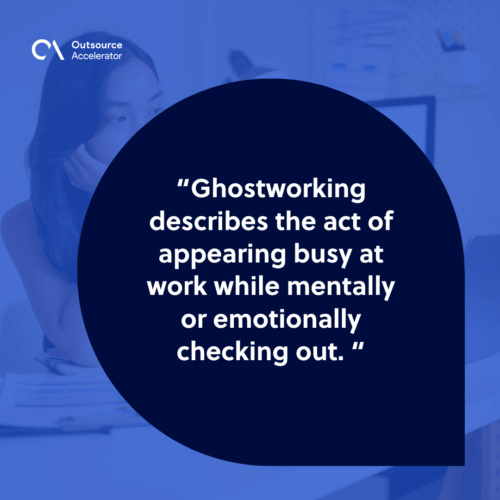Forget quiet quitting: Is ghostworking the evolution of employee disengagement?

The workplace has witnessed a remarkable transformation in recent years. The Great Resignation disrupted traditional patterns as employees abandoned roles in pursuit of purpose and autonomy.
This shift gave way to quiet quitting, where disengaged workers perform only necessary tasks while suffering high stress, sadness, and low morale.
In the UK, Gallup found that just 33% of employees felt truly engaged in 2024, leaving 67% of the workforce emotionally detached. Underlying causes such as burnout, toxic management, and meaningless work have driven this trend.
Now, a subtler behaviour is emerging: ghostworking. It has employees projecting busyness, though definitions remain fluid.
This article explores that progression: how disengagement evolved across these trends and why ghostworking might signal the next stage in employee disconnection.
What is ghostworking?
Ghostworking describes the act of appearing busy at work while mentally or emotionally checking out. Employees who ghostwork often attend meetings, respond to messages, and meet surface-level expectations, but they avoid meaningful engagement or contribution.
This behavior typically stems from dissatisfaction, burnout, or a desire to leave without drawing attention. Unlike quiet quitting, ghostworking involves maintaining the illusion of productivity while actively detaching behind the scenes.
Some even use work hours to apply for new jobs, freelance under the radar, or delegate tasks without accountability.
For example, a ghostworking employee may log into every scheduled video call but remain silent, provide vague updates, and recycle old work to seem active. While they technically stay on the payroll, their commitment to the role has vanished.
Ghostworking signals a deeper issue within workplace culture.

Primary causes of ghostworking
Most professionals have experienced moments when their motivation dips and their focus drifts. For employees, this might mean going through the motions without true engagement. For leaders, it’s a red flag that something deeper may be broken in the workplace.
Ghostworking doesn’t appear overnight; it often builds in response to unresolved frustrations or unmet needs. Below are the most common causes driving this growing trend:
1. Burnout and emotional exhaustion
When employees feel stretched too thin, they begin to shut down. Long hours, unrealistic expectations, and a lack of support drain energy and enthusiasm.
Instead of quitting, some choose to coast through the day to protect their mental health. Ghostworking becomes a coping mechanism, a way to survive without collapsing.
2. Lack of purpose or meaning
People want to feel their work matters. Tasks that feel repetitive, disconnected, or pointless can quickly lead to disengagement.
If employees don’t see the impact of their efforts, they lose interest. This behavior often begins when workers stop believing their contribution makes a difference.
3. Toxic or micromanaged work environments
Leadership style has a significant influence on employee behavior. In environments ruled by fear, mistrust, or micromanagement, people often disengage to avoid confrontation.
Ghostworking allows them to keep their heads down and avoid further stress while plotting an exit.
4. Lack of career growth or recognition
Employees who feel stuck or invisible tend to mentally check out. When promotions, feedback, or development opportunities never materialize, ambition fades.
Ghostworking becomes a quiet protest, a signal that they’ve stopped expecting progress and started looking elsewhere.
5. Remote work isolation
Remote setups can leave employees feeling disconnected from teams, managers, and company culture. Without regular interaction or strong communication, some begin to detach. Ghostworking slips in when people feel forgotten or unseen in a digital workspace.
These causes are often interconnected, creating a slow fade into disengagement. The remainder of the article will examine how leaders can identify ghostworking and address its underlying causes before productivity and morale decline further.
How business leaders can combat ghostworking
Both employees and leaders want to feel connected, valued, and productive at work. Addressing this issue in the workplace requires more than tighter supervision, as it demands a thoughtful, people-focused approach.
Here’s how leaders can start turning things around:
1. Open clear channels of communication
Leaders who maintain honest, consistent conversations build stronger trust across teams. Regular one-on-one check-ins, feedback loops, and space for concerns can reveal early signs of disengagement.
Communication creates connection, and connection prevents withdrawal.
2. Reconnect work to purpose
When employees understand the impact of their role, they’re more likely to stay engaged. Leaders can highlight how tasks contribute to broader goals, celebrate wins, and tie work to real-world outcomes.
A clear sense of purpose helps people care again.
3. Invest in career growth
Stagnant roles often lead to quiet withdrawal. Leaders should offer training, development programs, and pathways for advancement.
Employees who see a future with the company stay mentally present in their current roles.
4. Create a culture of recognition
Appreciation motivates. Simple acknowledgments like public praise, written notes, or small rewards can rekindle lost engagement. Recognition makes people feel seen, especially in remote or hybrid settings.
5. Prioritize wellbeing and workload balance
Overloaded teams burn out fast. Leaders must spot signs of fatigue early and adjust expectations when needed. Promoting healthy work habits signals long-term commitment to employee success, not just output.
Addressing ghostworking means tackling its root causes directly. When leaders create an environment where people feel safe, supported, and inspired, disengagement fades, and genuine productivity returns.
Ghostworking: The silent driver for better work
Ghostworking reveals more than quiet disengagement. It signals what’s missing in the present work environments. Employees crave purpose, balance, and recognition. Leaders who listen and adapt can turn silent withdrawal into honest feedback and lasting improvement.
When organizations treat disengagement as a symptom, not a threat, they open the door to stronger cultures and better leadership. Businesses that act now will build teams that show up with focus, loyalty, and drive.

Ghostworking FAQs
Below are frequently asked questions that explore this growing workplace trend:
How is ghostworking different from quiet quitting?
Quiet quitting involves doing only what a job requires without extra effort. Ghostworking, however, involves maintaining the illusion of productivity while mentally checking out and sometimes looking for other jobs during work hours.
Why do employees ghostwork?
Burnout, dissatisfaction, lack of recognition, and a desire to leave without confrontation are common reasons employees begin to ghostwork.
What are the signs of ghostworking?
Typical signs include vague status updates, minimal participation in meetings, recycling old work, and a general lack of initiative or creativity.
What impact does ghostworking have on teams?
Ghostworking can lower team morale, shift workloads unfairly, and create gaps in performance, often leading to frustration among more engaged team members.
What does ghostworking reveal about a company?
It signals deeper cultural or management issues, such as poor leadership, lack of engagement, or unaddressed employee concerns, that need attention.







 Independent
Independent




